Chen Qian
Voronoi-Assisted Diffusion for Computing Unsigned Distance Fields from Unoriented Points
Oct 14, 2025Abstract:Unsigned Distance Fields (UDFs) provide a flexible representation for 3D shapes with arbitrary topology, including open and closed surfaces, orientable and non-orientable geometries, and non-manifold structures. While recent neural approaches have shown promise in learning UDFs, they often suffer from numerical instability, high computational cost, and limited controllability. We present a lightweight, network-free method, Voronoi-Assisted Diffusion (VAD), for computing UDFs directly from unoriented point clouds. Our approach begins by assigning bi-directional normals to input points, guided by two Voronoi-based geometric criteria encoded in an energy function for optimal alignment. The aligned normals are then diffused to form an approximate UDF gradient field, which is subsequently integrated to recover the final UDF. Experiments demonstrate that VAD robustly handles watertight and open surfaces, as well as complex non-manifold and non-orientable geometries, while remaining computationally efficient and stable.
SpotVLM: Cloud-edge Collaborative Real-time VLM based on Context Transfer
Aug 18, 2025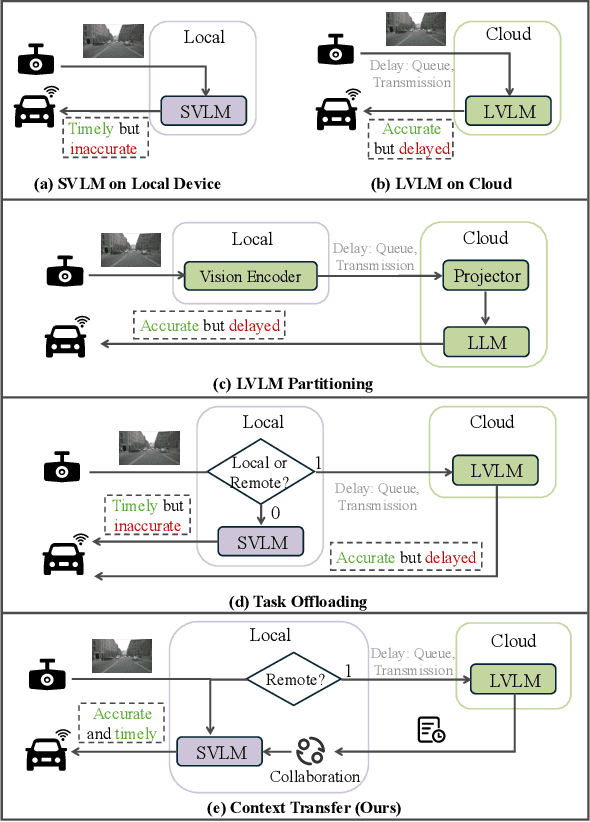

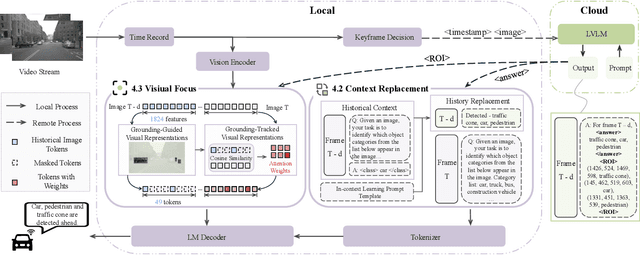
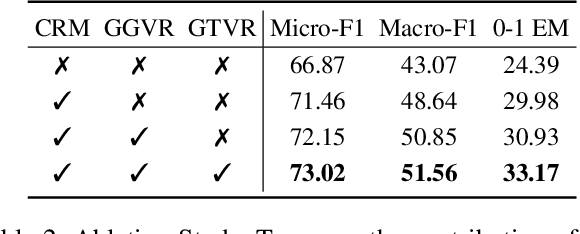
Abstract:Vision-Language Models (VLMs) are increasingly deployed in real-time applications such as autonomous driving and human-computer interaction, which demand fast and reliable responses based on accurate perception. To meet these requirements, existing systems commonly employ cloud-edge collaborative architectures, such as partitioned Large Vision-Language Models (LVLMs) or task offloading strategies between Large and Small Vision-Language Models (SVLMs). However, these methods fail to accommodate cloud latency fluctuations and overlook the full potential of delayed but accurate LVLM responses. In this work, we propose a novel cloud-edge collaborative paradigm for VLMs, termed Context Transfer, which treats the delayed outputs of LVLMs as historical context to provide real-time guidance for SVLMs inference. Based on this paradigm, we design SpotVLM, which incorporates both context replacement and visual focus modules to refine historical textual input and enhance visual grounding consistency. Extensive experiments on three real-time vision tasks across four datasets demonstrate the effectiveness of the proposed framework. The new paradigm lays the groundwork for more effective and latency-aware collaboration strategies in future VLM systems.
OpenMoCap: Rethinking Optical Motion Capture under Real-world Occlusion
Aug 18, 2025Abstract:Optical motion capture is a foundational technology driving advancements in cutting-edge fields such as virtual reality and film production. However, system performance suffers severely under large-scale marker occlusions common in real-world applications. An in-depth analysis identifies two primary limitations of current models: (i) the lack of training datasets accurately reflecting realistic marker occlusion patterns, and (ii) the absence of training strategies designed to capture long-range dependencies among markers. To tackle these challenges, we introduce the CMU-Occlu dataset, which incorporates ray tracing techniques to realistically simulate practical marker occlusion patterns. Furthermore, we propose OpenMoCap, a novel motion-solving model designed specifically for robust motion capture in environments with significant occlusions. Leveraging a marker-joint chain inference mechanism, OpenMoCap enables simultaneous optimization and construction of deep constraints between markers and joints. Extensive comparative experiments demonstrate that OpenMoCap consistently outperforms competing methods across diverse scenarios, while the CMU-Occlu dataset opens the door for future studies in robust motion solving. The proposed OpenMoCap is integrated into the MoSen MoCap system for practical deployment. The code is released at: https://github.com/qianchen214/OpenMoCap.
Multi-module GRPO: Composing Policy Gradients and Prompt Optimization for Language Model Programs
Aug 06, 2025Abstract:Group Relative Policy Optimization (GRPO) has proven to be an effective tool for post-training language models (LMs). However, AI systems are increasingly expressed as modular programs that mix together multiple LM calls with distinct prompt templates and other tools, and it is not clear how best to leverage GRPO to improve these systems. We begin to address this challenge by defining mmGRPO, a simple multi-module generalization of GRPO that groups LM calls by module across rollouts and handles variable-length and interrupted trajectories. We find that mmGRPO, composed with automatic prompt optimization, improves accuracy by 11% on average across classification, many-hop search, and privacy-preserving delegation tasks against the post-trained LM, and by 5% against prompt optimization on its own. We open-source mmGRPO in DSPy as the dspy.GRPO optimizer.
SafeWork-R1: Coevolving Safety and Intelligence under the AI-45$^{\circ}$ Law
Jul 24, 2025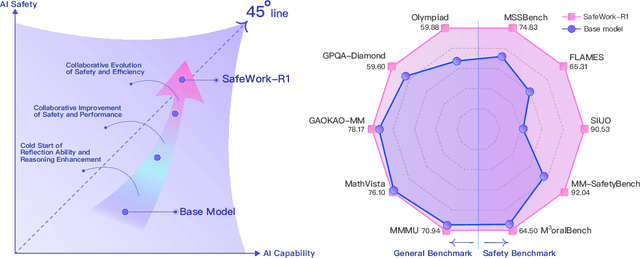
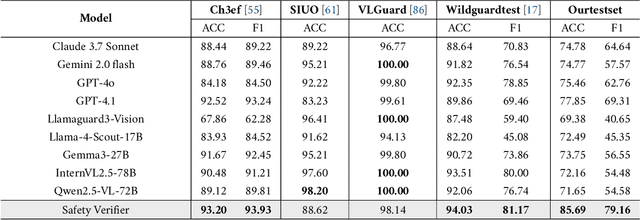
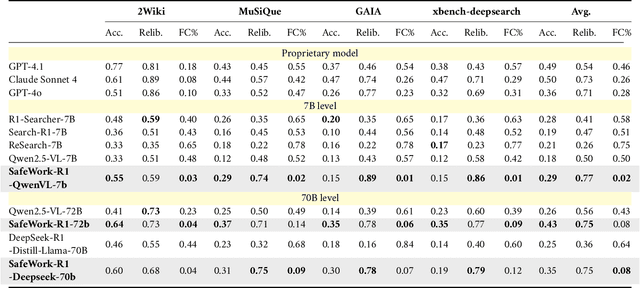

Abstract:We introduce SafeWork-R1, a cutting-edge multimodal reasoning model that demonstrates the coevolution of capabilities and safety. It is developed by our proposed SafeLadder framework, which incorporates large-scale, progressive, safety-oriented reinforcement learning post-training, supported by a suite of multi-principled verifiers. Unlike previous alignment methods such as RLHF that simply learn human preferences, SafeLadder enables SafeWork-R1 to develop intrinsic safety reasoning and self-reflection abilities, giving rise to safety `aha' moments. Notably, SafeWork-R1 achieves an average improvement of $46.54\%$ over its base model Qwen2.5-VL-72B on safety-related benchmarks without compromising general capabilities, and delivers state-of-the-art safety performance compared to leading proprietary models such as GPT-4.1 and Claude Opus 4. To further bolster its reliability, we implement two distinct inference-time intervention methods and a deliberative search mechanism, enforcing step-level verification. Finally, we further develop SafeWork-R1-InternVL3-78B, SafeWork-R1-DeepSeek-70B, and SafeWork-R1-Qwen2.5VL-7B. All resulting models demonstrate that safety and capability can co-evolve synergistically, highlighting the generalizability of our framework in building robust, reliable, and trustworthy general-purpose AI.
Cross-Task Experiential Learning on LLM-based Multi-Agent Collaboration
May 29, 2025Abstract:Large Language Model-based multi-agent systems (MAS) have shown remarkable progress in solving complex tasks through collaborative reasoning and inter-agent critique. However, existing approaches typically treat each task in isolation, resulting in redundant computations and limited generalization across structurally similar tasks. To address this, we introduce multi-agent cross-task experiential learning (MAEL), a novel framework that endows LLM-driven agents with explicit cross-task learning and experience accumulation. We model the task-solving workflow on a graph-structured multi-agent collaboration network, where agents propagate information and coordinate via explicit connectivity. During the experiential learning phase, we quantify the quality for each step in the task-solving workflow and store the resulting rewards along with the corresponding inputs and outputs into each agent's individual experience pool. During inference, agents retrieve high-reward, task-relevant experiences as few-shot examples to enhance the effectiveness of each reasoning step, thereby enabling more accurate and efficient multi-agent collaboration. Experimental results on diverse datasets demonstrate that MAEL empowers agents to learn from prior task experiences effectively-achieving faster convergence and producing higher-quality solutions on current tasks.
Co-Saving: Resource Aware Multi-Agent Collaboration for Software Development
May 28, 2025Abstract:Recent advancements in Large Language Models (LLMs) and autonomous agents have demonstrated remarkable capabilities across various domains. However, standalone agents frequently encounter limitations when handling complex tasks that demand extensive interactions and substantial computational resources. Although Multi-Agent Systems (MAS) alleviate some of these limitations through collaborative mechanisms like task decomposition, iterative communication, and role specialization, they typically remain resource-unaware, incurring significant inefficiencies due to high token consumption and excessive execution time. To address these limitations, we propose a resource-aware multi-agent system -- Co-Saving (meaning that multiple agents collaboratively engage in resource-saving activities), which leverages experiential knowledge to enhance operational efficiency and solution quality. Our key innovation is the introduction of "shortcuts" -- instructional transitions learned from historically successful trajectories -- which allows to bypass redundant reasoning agents and expedite the collective problem-solving process. Experiments for software development tasks demonstrate significant advantages over existing methods. Specifically, compared to the state-of-the-art MAS ChatDev, our method achieves an average reduction of 50.85% in token usage, and improves the overall code quality by 10.06%.
Multi-Agent Collaboration via Evolving Orchestration
May 26, 2025



Abstract:Large language models (LLMs) have achieved remarkable results across diverse downstream tasks, but their monolithic nature restricts scalability and efficiency in complex problem-solving. While recent research explores multi-agent collaboration among LLMs, most approaches rely on static organizational structures that struggle to adapt as task complexity and agent numbers grow, resulting in coordination overhead and inefficiencies. To this end, we propose a puppeteer-style paradigm for LLM-based multi-agent collaboration, where a centralized orchestrator ("puppeteer") dynamically directs agents ("puppets") in response to evolving task states. This orchestrator is trained via reinforcement learning to adaptively sequence and prioritize agents, enabling flexible and evolvable collective reasoning. Experiments on closed- and open-domain scenarios show that this method achieves superior performance with reduced computational costs. Analyses further reveal that the key improvements consistently stem from the emergence of more compact, cyclic reasoning structures under the orchestrator's evolution.
MASLab: A Unified and Comprehensive Codebase for LLM-based Multi-Agent Systems
May 22, 2025Abstract:LLM-based multi-agent systems (MAS) have demonstrated significant potential in enhancing single LLMs to address complex and diverse tasks in practical applications. Despite considerable advancements, the field lacks a unified codebase that consolidates existing methods, resulting in redundant re-implementation efforts, unfair comparisons, and high entry barriers for researchers. To address these challenges, we introduce MASLab, a unified, comprehensive, and research-friendly codebase for LLM-based MAS. (1) MASLab integrates over 20 established methods across multiple domains, each rigorously validated by comparing step-by-step outputs with its official implementation. (2) MASLab provides a unified environment with various benchmarks for fair comparisons among methods, ensuring consistent inputs and standardized evaluation protocols. (3) MASLab implements methods within a shared streamlined structure, lowering the barriers for understanding and extension. Building on MASLab, we conduct extensive experiments covering 10+ benchmarks and 8 models, offering researchers a clear and comprehensive view of the current landscape of MAS methods. MASLab will continue to evolve, tracking the latest developments in the field, and invite contributions from the broader open-source community.
NOVER: Incentive Training for Language Models via Verifier-Free Reinforcement Learning
May 21, 2025Abstract:Recent advances such as DeepSeek R1-Zero highlight the effectiveness of incentive training, a reinforcement learning paradigm that computes rewards solely based on the final answer part of a language model's output, thereby encouraging the generation of intermediate reasoning steps. However, these methods fundamentally rely on external verifiers, which limits their applicability to domains like mathematics and coding where such verifiers are readily available. Although reward models can serve as verifiers, they require high-quality annotated data and are costly to train. In this work, we propose NOVER, NO-VERifier Reinforcement Learning, a general reinforcement learning framework that requires only standard supervised fine-tuning data with no need for an external verifier. NOVER enables incentive training across a wide range of text-to-text tasks and outperforms the model of the same size distilled from large reasoning models such as DeepSeek R1 671B by 7.7 percent. Moreover, the flexibility of NOVER enables new possibilities for optimizing large language models, such as inverse incentive training.
 Add to Chrome
Add to Chrome Add to Firefox
Add to Firefox Add to Edge
Add to Edge